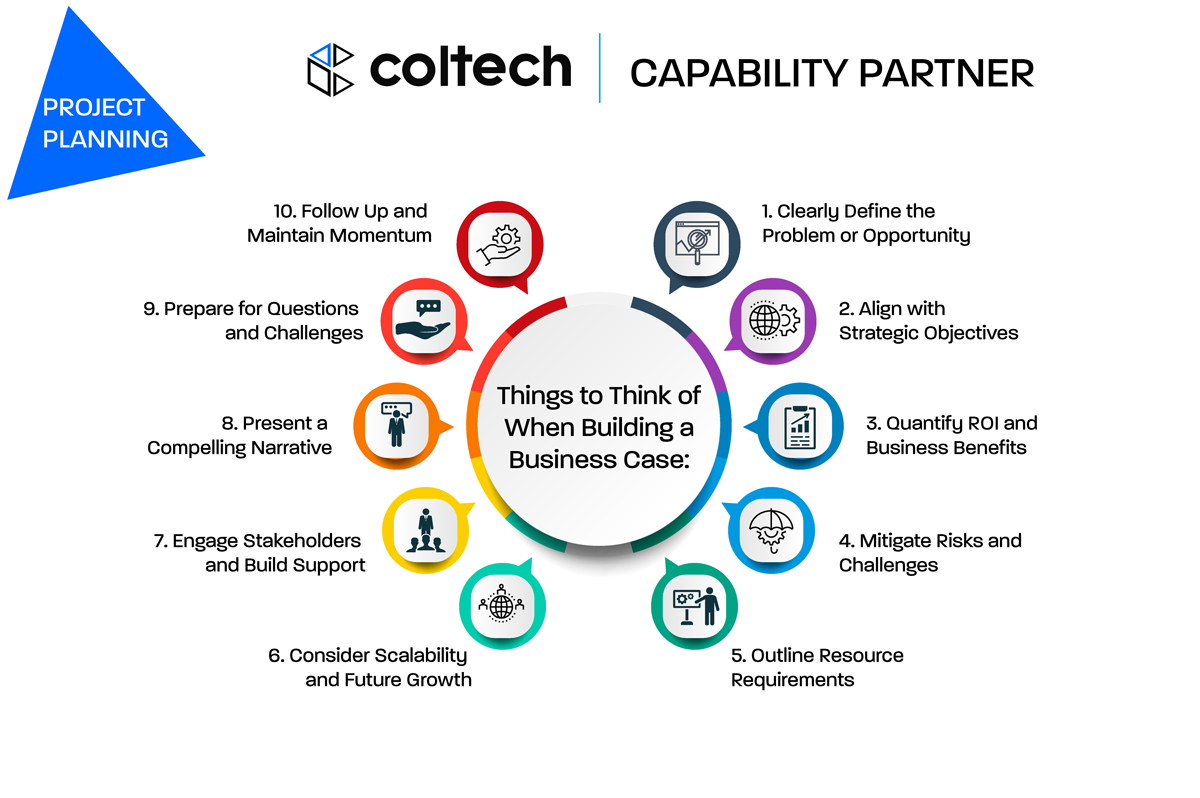
As a Chief Technology Officer (CTO), presenting a business case for a new project to your executive team is a critical step in driving innovation and achieving organizational goals. Whether you're proposing a new software development initiative, implementing advanced technology solutions, or upgrading infrastructure, building a compelling business case is essential for securing buy-in and resources.
What we’ve also found from CTOs, is the act of developing a business case is as much about refining and validating the project idea for the project leader as it is about persuading the board or investors. It's a fundamental step that sets the foundation for project success.
Here are key considerations to keep in mind when crafting your business case:
1. Clearly Define the Problem or Opportunity:
Begin by articulating the specific problem or opportunity that the proposed project aims to address. Provide context and evidence to illustrate the significance and urgency of the issue. Clearly communicate the potential impact on the organization, whether it's improving efficiency, enhancing customer experience, or generating revenue opportunities.
2. Align with Strategic Objectives:
Ensure that your proposed project aligns closely with the organization's strategic objectives and priorities. Demonstrate how it supports the company's mission, vision, and long-term goals. Highlight the strategic benefits and value proposition of the project, emphasizing how it contributes to competitive advantage, market differentiation, or growth.
So for example a Cloud and Analytics project may detail the following:
Migrating to a cloud infrastructure with enhanced data analytics aligns with strategic goals of scalability, agility, and data-driven decision-making. This move supports growth by providing scalable resources to handle increasing data volumes and customer interactions efficiently. It enhances competitiveness through agility, allowing rapid deployment of new services.
The integration of advanced analytics facilitates deeper insights into customer behavior and market trends, driving innovation and personalized offerings. Ultimately, this migration positions the company for sustainable growth, operational efficiency, and a stronger competitive edge by leveraging cloud capabilities and data insights.
3. Quantify ROI and Business Benefits:
Quantify the return on investment (ROI) and business benefits associated with the proposed project. Estimate the financial implications, including cost savings, revenue generation, and potential profitability. Use data-driven analysis, such as cost-benefit analysis or net present value (NPV) calculations, to substantiate your projections and justify investment.
4. Mitigate Risks and Challenges:
Identify and assess potential risks, challenges, and obstacles that may impact the success of the project. Develop a risk management plan outlining proactive measures to mitigate risks and minimize negative impacts. Address concerns related to technology adoption, market dynamics, regulatory compliance, and organizational change management.
5. Outline Resource Requirements:
Clearly outline the resource requirements for executing the project, including budget, staffing, technology infrastructure, and external expertise. Provide a detailed breakdown of costs, timelines, and dependencies to facilitate informed decision-making by the executive team. Consider alternative resource allocation strategies and explore options for leveraging existing assets or partnerships.
6. Consider Scalability and Future Growth:
Anticipate future scalability requirements and consider the long-term implications of the proposed project. Evaluate its potential to accommodate growth, scalability, and evolving business needs over time. Demonstrate how the project lays the foundation for future innovation, expansion, and sustainability.
Incorporating an assessment of software and vendor platform stability into your business case is a critical component of planning for scalability and future growth. This consideration ensures that the chosen technology solution can reliably support your business as it expands, maintaining seamless operations and user satisfaction. By selecting stable platforms known for ongoing support and development, you secure a foundation that not only meets current needs but is also equipped to integrate future innovations.
This strategic focus on stability aids in risk identification and mitigation, preparing your project to adapt and thrive amidst evolving business requirements and technological advancements.
7. Engage Stakeholders and Build Support:
Engage key stakeholders early in the process and solicit their input and feedback to ensure alignment and build support. Tailor your messaging to resonate with different stakeholders, addressing their concerns, priorities, and interests. Build a coalition of advocates and champions who can advocate for the project within the organization.
8. Present a Compelling Narrative:
Craft a compelling narrative that resonates with the executive team and conveys the urgency and importance of the proposed project. Understand what the key topics have been in recent board meetings and align your proposal with them. Use clear, concise language and compelling visuals to illustrate key points and make a persuasive case. Frame the business case in terms of opportunities seized and risks mitigated, emphasizing the positive outcomes and value proposition.
9. Prepare for Questions and Challenges:
Anticipate questions, objections, and challenges that may arise during the presentation, and prepare thoughtful responses in advance. Be open to constructive feedback and demonstrate a willingness to address concerns and refine the business case as needed. Leverage data, evidence, and expert opinions to support your arguments and build credibility.
10. Follow Up and Maintain Momentum:
After presenting the business case, follow up with the executive team to address any outstanding questions or concerns and provide additional information as needed. Maintain momentum by keeping stakeholders informed and engaged throughout the decision-making process. Demonstrate a commitment to transparency, accountability, and collaboration as you work towards project approval and execution.
Coltech Example
Coltech were able to help the CTO of a Global eCommerce business build the business case for a new web application. The CTO recognised the need for a robust business case that he could bring to the executive team. We worked alongside the business to analyse the company's current technological landscape, identified pain points, and assessed market trends to craft a compelling argument.
We conducted a thorough cost-benefit analysis, projecting the potential return on investment (ROI) over a defined timeline. They highlighted the cost savings from process optimization, revenue growth through enhanced customer engagement, and competitive advantages gained from staying ahead of technological trends.
Armed with this comprehensive business case, the CTO presented to the executive team, confidently demonstrating the strategic importance and tangible benefits of the proposed web application build. Thanks to Coltech's support, the CTO successfully gained executive buy-in, paving the way for the project's approval and eventual implementation, driving innovation and growth within the organization.
Conclusion
Building a compelling business case for a new project requires careful planning, strategic thinking, and effective communication. By clearly defining the problem or opportunity, aligning with strategic objectives, quantifying ROI, mitigating risks, outlining resource requirements, considering scalability, engaging stakeholders, presenting a compelling narrative, preparing for challenges, and maintaining momentum, CTOs can increase the likelihood of securing executive buy-in and driving successful project outcomes.





